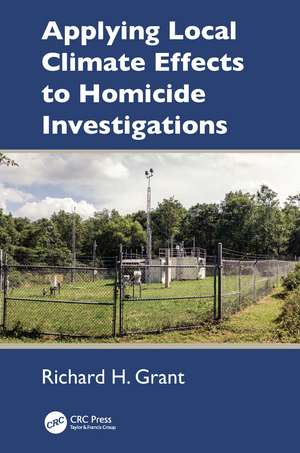Applying Local Climate Effects to Homicide Investigations
Autor Richard H. Granten Limba Engleză Paperback – 7 feb 2025
The information derived from such instruments and weather reporting services and agencies can inform and impact investigations, especially in the case of natural death or homicide cases. The determination of post-mortem interval (PMI) in homicide cases is often based on entomological or anthropological evidence in combination with local climate estimations. Determining the local climate conditions typically requires knowledge of the environmental conditions where the body is found and the conditions where the measurement record was made. Most people recognize that cities are hotter than the surrounding countryside and that lake and coastal shorelines are cooler than fields: all of these comprise local climates. The local climate where a corpse is discovered usually differs from where temperature and humidity measurements are made. Consequently, many investigators and forensic pathologists do not realize the influence that such local temperatures and humidity can have on post-mortem interval determinations.
The book focuses on local climate conditions associated with the determination of post-mortem interval (PMI) and gives concepts behind adjusting climate information for local climates at the corpse. In addition, the book will present guidelines for crime scene investigators and lawyers to determine whether or not expert consultation is needed, and whether or not on-site measurements are needed. Most importantly, Applying Local Climate Effects to Homicide Investigation presents tools (data sources and modelling approaches) to guide forensic climatologists conducting forensic climatology work. It offers a basic, working understanding of the influence of the local environment on the local climate for forensic entomologists, forensic anthropologists, crime scene investigators, and lawyers. Numerous case studies are included throughout to show approaches, illustration decision points, and provide an understanding of the various impacts of regional and micro-climates upon decedents and their remains.
Preț: 445.57 lei
Preț vechi: 524.20 lei
-15% Nou
Puncte Express: 668
Preț estimativ în valută:
85.32€ • 88.01$ • 70.71£
85.32€ • 88.01$ • 70.71£
Carte nepublicată încă
Doresc să fiu notificat când acest titlu va fi disponibil:
Se trimite...
Preluare comenzi: 021 569.72.76
Specificații
ISBN-13: 9781032781853
ISBN-10: 1032781858
Pagini: 208
Ilustrații: 110
Dimensiuni: 156 x 234 mm
Greutate: 0.27 kg
Ediția:1
Editura: Taylor & Francis
Colecția CRC Press
Locul publicării:Oxford, United Kingdom
ISBN-10: 1032781858
Pagini: 208
Ilustrații: 110
Dimensiuni: 156 x 234 mm
Greutate: 0.27 kg
Ediția:1
Editura: Taylor & Francis
Colecția CRC Press
Locul publicării:Oxford, United Kingdom
Public țintă
Professional Practice & Development and Professional ReferenceCuprins
1. Introduction and overview
2. How local climate affects PMI estimates using entomological methods
Neal H. Haskell and Leon G. Higley
3. How local climate affects PMI estimates using anthropological methods
4. Controls on local climate temperature
5. Controls on local climate humidity
6. Microclimate of the corpse location: what to consider
7. Sources of and problems with climate records
8. Post-discovery on-site measurements
9. Modeling the corpse microclimate
10. How do measurement and modeling errors affect the specificity of PMI estimates
Glossary
Appendices: Case studies
2. How local climate affects PMI estimates using entomological methods
Neal H. Haskell and Leon G. Higley
3. How local climate affects PMI estimates using anthropological methods
4. Controls on local climate temperature
5. Controls on local climate humidity
6. Microclimate of the corpse location: what to consider
7. Sources of and problems with climate records
8. Post-discovery on-site measurements
9. Modeling the corpse microclimate
10. How do measurement and modeling errors affect the specificity of PMI estimates
Glossary
Appendices: Case studies
Notă biografică
Richard H. Grant is a Professor of Agronomy and Agro-Micrometeorology at Purdue University who has consulted over the past 30 years in forensic climatology for 10 homicide cases in Ontario, Canada, Indiana, New Mexico, Illinois, North Carolina, Tennessee, Texas, Kansas, New Mexico, and Montana—in addition to having conducted climatological investigations for several non-homicide court cases, insurance claims, and environmental compliance issues. He has taught over 60 course-semesters on topics including climate, local climate, microclimate, forensic climatology and meteorological science at Purdue University, State University of New York College of Environmental Science and Forestry and St. Joseph’s College since 1983. He has authored over 170 articles and over 140 conference abstracts or proceedings addressing many aspects of local climates. While he has authored seven book chapters, this is his first published book.
Descriere
Applying Local Climate Effects to Homicide Investigation presents the concepts behind using local climate and weather records to enhance understanding of criminal cases.
